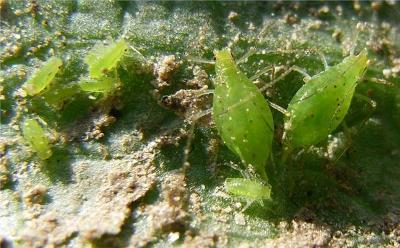Nov 8 2012
Researchers have found that a reduction in the amount of UV light in the environment can reduce the propagation and aphid population density what involves an overuse decline of pesticides.
 Colony of Macrosiphum euphorbiae on lettuce. Source: Alberto Fereres
Colony of Macrosiphum euphorbiae on lettuce. Source: Alberto Fereres
The use of UV-absorbing covers can reduce the incidence of the potato aphid, M. euphorbiae, on lettuce plants. This is the result found by the group of Integrated Pest Management at the ETS Agronomics engineering of the UPM in collaboration with the group Insects as Vectors of Plant Pathogens of the Instituto de Ciencias Agrarias at the CSIC.
The results suggest that UV-absorbing covers can be considered as relevant tools for the control of integrated aphids in covered crops, thereby enabling us to reduce pesticides applications what can have positive effects on the production cost as well as in the environment and human health.
The Integrated Pest Management (IPM) involves the use of multiple tactics to optimize the control of all types of pests. Among the control tactics that should be developed on IPM are included physical methods that can avoid waste materials and to minimize damage environment.
In this context, the UV-absorbing covers have proved to be helpful to reduce the impact of various insect pests as alphids, waterflies, thrips and moths. In fact, it is known that UV radiation is important in visual signs for the most of insects as they modify their flight and landing behavior.
Aphids are harmful to crops both indoor and outdoor and can cause substantial losses. In particular, Macrosiphum euphorbiae is one of the most harmful aphids in the world, this species can transmits dozens of plant viruses and to colonize many horticultural species.
Therefore, aphid was chosen to assess the effects of UV-absorbing covers on its development and spread. In this case, researchers analyzed whether the UV-absorbing cover (Bionet®) was able to reduce the incidence of the potato aphid (M. euphorbiae) in lettuce crops.
To carry out the present study1, they conducted tests for three seasons in lettuce greenhouses, some of the greenhouses were protected with conventional covers and others with Bionet® covers. They artificially infected the greenhouses with aphids. The population was estimated with weekly samplings in all plants.
This population grew exponentially in both environments, but it was significantly lower when aphids were under the UV-absorbing covers. Similarly, life table parameters were reduced under the Bionet® covers in laboratory conditions. In addition, the statistical analysis showed that spatial distribution of aphids decreased in environment poor in UV light.
Therefore, the results indicated that UV-absorbing covers should be considered as an important tool to take into consideration in the integrated control of aphids in indoor crops, to encourage reducing the application of pesticides.
Besides this study, the unit of crop protection at the E.T.S Agronomics engineering of the UPM in collaboration with the group Insects as Vectors of Plant Pathogens at the CSIC have a line of collaboration thanks to national projects to study new aspects such as the effect of UV-absorbing covers over natural enemies of pests and plant viruses.